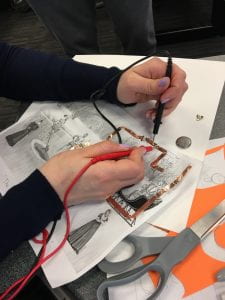English 1102, Visual Culture and H. Rider Haggard
Spring 2017
Professor: Kate Holterhoff
 Project Description
Project Description
This art work is a sample of student work created in Dr. Kate Holterhoff’s English 1102 classes and Georgia Tech’s Writing & Communication Program. In this section of English 1102, students learned about key concepts in visual culture and digital archives by studying the fictions and legacy of nineteenth-century British author H. Rider Haggard.
This project asked students to write a script and record a 4 to 7-minute audio guide to accompany one illustration from Visual Haggard. Students also created their own visual interpretations of the text captioned beneath this same illustration. These collaged illustrations were to reimagine, reinterpret, and remix Haggard’s text in new ways. Students participated in a series of workshops held at the Library. Students learned techniques for audio editing from Librarian Alison Valk and artistic methods for paper & photo collage, including paper circuits, from local artist Ashley Schick. Many of the pieces incorporate an interactive element, including lights. By making these illustrations haptically interactive and illuminated, students enhanced the audience experience with their projects.
Audio Guide to the Archives
This is sample audio file from the project. Each student created one to accompany their illustration.
Audio guides tell a story. Guides point out critical, historical, and aesthetic details that viewers might miss without curation. They are not summaries or lists; instead, guides make an argument about an artwork by telling listeners why it matters.
Process is a particularly important component of this project. Students critiqued Haggard’s graphic history rather than merely archiving and generating data around it. Students visited the High Museum of Art, and spoke with representatives from the museum’s curatorial staff, to create their own illustrations using collage and paper circuits, and reflect on the ideological content of these artworks.
Goals
This assignment challenges students in four ways:
- First, students must conduct substantive research.
- Second, students must articulate an argument using the oral and nonverbal means of communication.
- Third, students must preform close reading and identify a text’s underlying assumptions.
- Fourth, Students must generate multiple visual interpretations of a written text.
Technology
Software options to create their audio guides:

